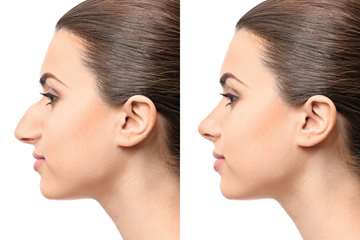(Rhinoplasty for Removing Nasal Humps)
Comprehensive Article on Hump Nose Removal Surgery

Comprehensive Article on Hump Nose Removal Surgery (Rhinoplasty for Removing Nasal Humps)
Introduction
Hump nose removal surgery, also known as rhinoplasty for removing nasal humps, is one of the most popular cosmetic surgeries. This procedure aims to correct the bump or hump on the nasal bridge, which may be caused by genetic factors or physical trauma. A nasal hump can significantly impact an individual’s appearance, especially in profile view, and may lead to dissatisfaction with one’s appearance. This article provides a detailed overview of nasal hump removal surgery, the reasons for choosing this procedure, the methods involved, its advantages and disadvantages, post-operative care, and expected outcomes.
Structure of the Nose and Nasal Hump
A nasal hump typically refers to a bump on the nasal bridge, which may be caused by excess growth of bone or cartilage. The nose consists of two major parts: the upper part, which is bony, and the lower part, made of cartilage. Nasal humps often appear in the bony part of the nasal bridge, manifesting as a noticeable bump.
The nasal hump can result from various factors, with genetics being one of the primary causes. For many individuals, a nasal hump appears as an inherited trait and may be common in certain families. Additionally, physical trauma, such as fractures or injuries to the nose, can lead to the development of a hump. These injuries may cause changes in the shape of the bone and cartilage, further accentuating the hump.
Besides affecting appearance, a nasal hump can negatively impact self-confidence. For many, the appearance of the hump in their profile may lead to dissatisfaction, which can directly affect their social relationships and self-esteem.
Reasons for Choosing Nasal Hump Removal Surgery
Nasal hump removal surgery is a popular procedure chosen by individuals for various reasons, including aesthetic or functional concerns. Below are some of the key reasons for opting for this surgery:
- Aesthetic Concerns
One of the main reasons for choosing this surgery is to improve the appearance of the nose. A nasal hump can make the nose appear larger and more prominent, affecting the overall facial harmony. Many individuals are dissatisfied with this bump and undergo surgery to achieve a smoother, more proportionate nose that aligns better with other facial features. These changes can significantly enhance the overall appearance and improve the individual’s profile. - Boosting Self-Confidence
Some individuals feel uncomfortable and dissatisfied with their appearance due to the presence of a nasal hump. This dissatisfaction can lower self-confidence, negatively impacting social and professional life. Nasal hump removal surgery can improve the nose’s appearance and create better facial balance, ultimately helping to boost the individual’s self-esteem. - Addressing Trauma-Induced Deformities
In some cases, a nasal hump results from past injuries or trauma to the nose. These injuries may cause fractures and bumps on the nasal bridge. Individuals who develop nasal humps due to previous trauma can benefit from this surgery, which not only improves appearance but also corrects any structural issues in the nose. - Genetic Factors
In certain individuals, nasal humps are inherited traits passed down through families. Those genetically predisposed to nasal humps may seek surgery to correct this feature and achieve their desired appearance.
Surgical Methods for Nasal Hump Removal
Nasal hump removal surgery can be performed using two main techniques: open rhinoplasty and closed rhinoplasty. The choice of technique depends on the size of the hump and the patient’s needs.
- Open Rhinoplasty
In open rhinoplasty, the surgeon makes a small incision on the columella (the base of the nose) to access the internal structure of the nose. This technique allows the surgeon to directly access the bone and cartilage and make the necessary adjustments. Open rhinoplasty is especially suitable for individuals with larger humps or those requiring more extensive structural changes.
One of the key advantages of open rhinoplasty is that it provides the surgeon with a full view of the nasal structure, enabling more precise adjustments. However, this technique typically requires a longer recovery period, and there may be a small scar at the base of the nose. - Closed Rhinoplasty
In closed rhinoplasty, all incisions are made inside the nose, with no external cuts. This technique is more suitable for patients who require minor changes and have smaller nasal humps. One of the benefits of this method is that there is no external scarring, and the recovery time is shorter. However, due to the limited view for the surgeon, closed rhinoplasty is less recommended for individuals requiring significant alterations.
Advantages and Disadvantages of Nasal Hump Removal Surgery
Nasal hump removal surgery comes with its own set of advantages and disadvantages, which patients should consider before undergoing the procedure.
Advantages
- Improved Nasal Appearance: This surgery helps enhance the overall shape of the nose, making it smoother and more proportionate with other facial features. The changes can significantly improve the individual’s profile.
- Increased Confidence: Many individuals feel more confident and satisfied with their appearance after surgery, leading to improved social interactions and relationships.
- Long-Lasting Results: Unlike non-surgical methods such as filler injections, the results of nasal hump removal surgery are permanent, allowing patients to enjoy long-term benefits.
Disadvantages
- Long Recovery Period: One of the disadvantages of this surgery is the long recovery period. After the procedure, patients may experience swelling and bruising for several weeks and will need to avoid strenuous physical activities.
- Surgical Risks and Complications: As with any surgery, nasal hump removal carries risks such as infection, bleeding, and issues with wound healing. Patients should ensure their surgeon is skilled and experienced to minimize these risks.
- Potential Need for Revision Surgery: In some cases, the initial results may not be fully satisfactory, requiring revision surgery. This is particularly common in cases with large humps or more complex nasal alterations.
Post-Operative Care for Nasal Hump Removal Surgery
Post-operative care plays a crucial role in faster recovery and achieving better results. Below are some essential post-surgery care tips for nasal hump removal surgery:
- Cold Compresses: Applying cold compresses after surgery helps reduce swelling and bruising, especially during the first few days following the procedure.
- Avoiding Strenuous Activities: Patients should refrain from engaging in heavy physical activities for several weeks to prevent increased swelling and pressure on the nose.
- Sleeping with Head Elevated: Elevating the head above the body while sleeping helps reduce swelling and promotes faster recovery. It is recommended to use multiple pillows to keep the head elevated.
- Regular Doctor Visits: Regular follow-up visits with the doctor are essential to monitor the healing process and address any potential issues promptly.
Results and Expectations
The final results of nasal hump removal surgery usually become fully apparent after several weeks. During this time, the swelling and bruising will gradually subside, revealing the final shape of the nose. Patients should have realistic expectations and understand that complete healing takes time. However, after full recovery, many patients are satisfied with the results and feel more confident about their appearance.
Conclusion
Nasal hump removal surgery is a common cosmetic procedure that enhances the appearance of the nose and creates better facial harmony. This surgery can have a significant impact on increasing an individual’s confidence. However, choosing a skilled surgeon and strictly following post-operative care instructions are crucial to achieving the best and most successful results.


comment